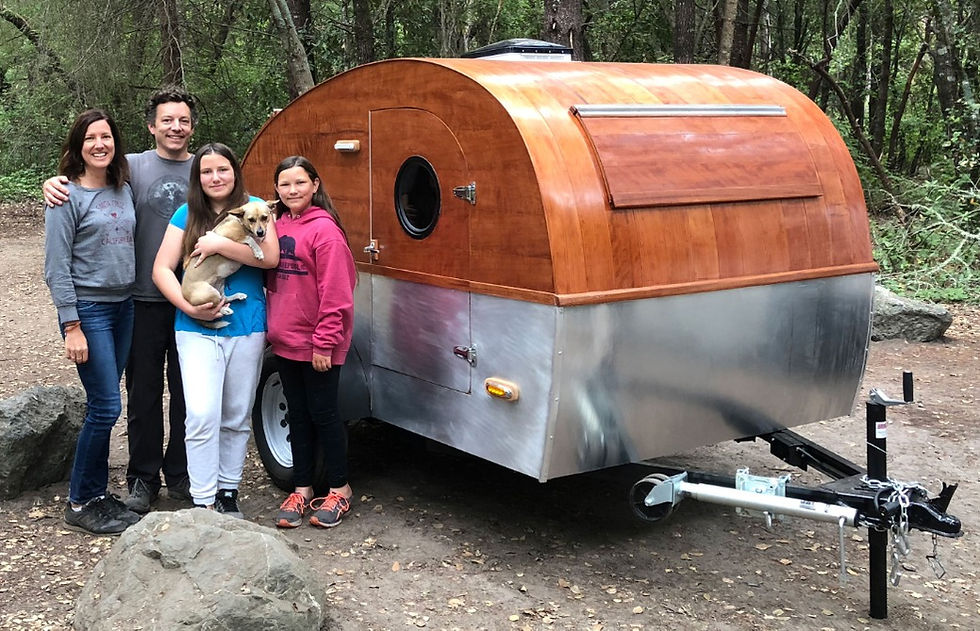New book chronicles teardrop construction in careful detail
by: Bob Phillips

If you have a hankering to build your own teardrop camper, a good place to start would be Matt Berger’s book, “The Handmade Teardrop Trailer,” scheduled for release on November 15. He’s taken all the guesswork out of a build. His teardrop project, named The Weekndr, is a classic teardrop design with a retro “woody” exterior made from thin panels of reclaimed redwood on top and aluminum below. Custom doors blend right in with continuous wood grain and matching curve.
Two-thirds of the 224-page book is devoted to construction details of Matt’s build, complete with many drawings and photographs, but he’s made available other useful information to the reader. For example, he includes a list of all construction materials and tools that will be needed, and even an Owners Manual.
He opens with the history of small campers, dating back to March 1919 when a Pennsylvania inventor obtained a patent for a tiny trailer. In 1935, Popular Homecraft magazine carried a story about a man in Pasadena, Calif., who built a teardrop. World War II paused the camper craze, but in 1945 Kit Kamper became the first to mass produce teardrops.

Writing the book was the easy part for Matt, who holds a journalism degree. It’s also his second how-to book, the first being “The Handmade Skateboard” (2014), both published by Nashville-based Spring House Press. Matt, 42, lives in Campbell, Calif., in the heart of Silicon Valley, with wife Mary and daughters Nina and Madeline. He is an enterprise product designer at Apple, but spent 15 years previously in the media and publishing industry.
What will readers find in this book?
“I’ve landed on a really great format for my how-to books that go something like this: I start with an introduction that sets out to uncover the industrial history of the object to understand how it came to be in the first place. One place I like to start is with the U.S. Patent and Trademark Office searchable online database looking up old patent applications. Do a keyword search for “Teardrop Trailer” and it will take you down a rabbit hole that predates the automobile. You’ll discover that no design idea is a new one.
“The introduction is followed by a chapter on design, which is intended to provide readers with design guidelines and boundaries so they can design a unique trailer that suits their needs. I provide lots of examples, variations, and I explore different ways to accomplish different design ambitions.
“The rest of the book is all about the build: 13 chapters that follow my build step by step. Along the way I explain where a reader might want to consider taking a different approach, and I’m always transparent about where I made mistakes so that others can avoid them.”

What sparked your interest in writing about DIY projects?
“I’ve been writing for a living for more than half my life. A few years out of college I was working as a tech journalist in San Francisco writing about Microsoft and the Internet when the Dot Com bubble burst and the tech economy started to tank. That’s when I came across my ‘dream job’ while reading one of my favorite magazines, Fine Woodworking. They had a posting for an associate editor and I immediately applied, attaching a portfolio of projects I had made in my spare time. They must have seen some potential in me because when I look back at that work I’m not sure I’d hire me based on my portfolio. We packed up our things and moved to the East Coast.

“Fine Woodworking" magazine is widely known for its high quality photos and information. During my seven years editing and publishing articles and videos for them, I essentially earned a master’s degree in furniture design and woodworking. I also learned what it takes to produce super high-quality how-to journalism. That job taught me everything I know about how to structure instructional information in a way that’s understandable and approachable for readers.
“When I left that job in 2010, I had the opportunity to start working on my first book with some former colleagues who started up the publishing company called Spring House Press.”
How did you decide to do a book on teardrop construction?
“I was eager to find another subject for my second book. I wanted to follow a similar format so I started looking around for commercial objects that started out originally made by hand in someone’s garage but had become popular commercial products manufactured in factories. It also had to be something unique enough that there wasn’t already a how-to book out on the subject to compete with.
“I discovered a really interesting woodworking project to build a hollow-wooden surfboard, and tried one out. But a few weeks into it I realized that the project would be too difficult to capture in a book, and even if it was possible I might not be the right person to write it; I’m afraid of the ocean!
“That’s when my publisher suggested the idea of a teardrop trailer. Originally I wasn’t big on the idea, but a year later my family and I started camping a lot around California and everyone kept complaining about sleeping on the ground, so the idea of a tiny camper started to sound more compelling. Once I started researching the topic and digging around the Web for building inspiration, I knew it was the right topic for my next book. I discovered a vibrant maker community that was underserved and on the precipice of really taking off. Tiny trailers are coming back in style, once again.”
You gave a lot of attention to design. Why?
“Design is my favorite part of every project I take on. It’s where I get to let my imagination run wild and not let the practicalities of construction get in the way of an idea. In fact, a lot of the times I don’t ever get to building something. I had so much fun designing it I don’t want to ruin it by finding out it can’t actually be built.
“I want readers to be successful with their builds and not have anything slow them down. So I made a huge effort to help readers really plan their build ahead of time to make sure they don’t run into unexpected delays or issues when they start to build. Some common problems are not having the right materials on hand when you get to a step -- that can slow you down a few weeks if it means sourcing and ordering materials or even just finding time to make a trip to the lumber yard. Another problem is designing a feature but not planning for it earlier in the process. That’s the case with my galley hatch door. I’m not sure why, but it was under planned and when I got to that step in the build I had to stop and solve my way out of a few big issues.”
What problems did you encounter?
“The good thing about not being a pro builder is that if I had a question about something during the build, most likely my readers would have the same questions, too. So my goal was to not only provide answers, but also give readers the context of each question to help them think critically about a problem and answer it their own way.
“A lot of DIY books just give you a list of instructions to make something; do it like this and here’s how it should turn out. That doesn’t give the reader any autonomy to be creative. I like to let the reader in on my decisions so that they can really make it their own. That’s what keeps the project relevant for years to come; you can always adapt it to materials and styles of the time.

“I ran into a number of challenges that really freaked me out. But ultimately, I managed to find my way out of every one of them by asking questions of smart people and through a lot of trial and error. I’m happy to report that the teardrop trailer community is full of supportive makers who are always willing to share their experience.
“In the end of the day, almost every challenge had to do with water -- keeping it out mostly. The biggest area of concern was with my custom-made side entry doors. To be honest, they still don’t keep the water out completely when you take the garden hose to the side walls at full blast. Solving that is going to be my winter project!” As a result of this book, Matt decided to do a Handmade Teardrop Trailer Maker’s Mark to collect information from builders about their project. “My goal is to create the world’s largest directory of handmade teardrop trailers,” he said.
“One of the most exciting parts about writing how-to books and articles is seeing what the community does with that information. After I published “The Handmade Skateboard,” I would receive emails or get tagged in social media posts from people who used my book to design and build their own skateboard.
“So with this book, I decided to create a place from the start where I could collect stories from people who built a trailer based on my book. Then I realized, why limit it to the future, why not invite anyone who built their own?

“That’s when I came up for the idea of my Handmade Teardrop Trailer Maker’s Mark. It’s essentially an open source that anyone who built their own teardrop can use to identify their build. Submit photos and a description of your build, and you’ll receive a unique number -- beginning with #0001 -- based on the rank in which your trailer was registered, first come first serve.”
Matt encourages folks to not be afraid to take on a trailer project. “My goal with every book I write is to take the fear and uncertainty out of complex building projects, and encourage people to go for it,” he said. “Every building challenge has a solution. I want to give people the confidence to solve every challenge that comes at them with the tools, space, and skills at their disposal.”
“If you’re willing to part with your garage for a few months, and have some experience with basic hand and power tools, there’s nothing that should stop you from taking on a building project of this size.
“Building your own teardrop trailer takes a lot of time and effort, but once you’re out in the wilderness having fun on a camping trip, with electricity and a warm mattress to sleep on, you realize all the sweat, tears, and band aids were worth it.”













Comments